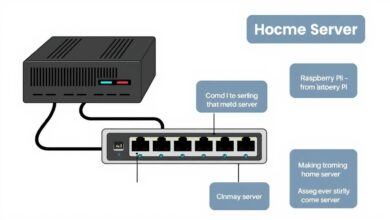Choosing Your First Server: Physical vs. Cloud vs. VPS – The Ultimate Guide

Selecting the right foundation for your website, application, or business data is crucial. When it comes to choosing your first server, the decision often boils down to three main contenders: physical (on-premise) servers, cloud hosting, and Virtual Private Servers (VPS). Each option presents distinct advantages and disadvantages regarding cost, performance, scalability, and control. Understanding these differences is the first step towards making an informed decision that aligns with your specific needs and future growth plans.
Making the wrong choice can lead to performance bottlenecks, unexpected costs, or limitations on scalability down the line. This guide will break down the core aspects of physical servers, cloud hosting, and VPS to help you navigate the process of choosing your first server effectively.
[Hint: Insert image/video comparing icons or graphics representing Physical, Cloud, and VPS servers here]Understanding Physical (On-Premise) Servers
A physical server, often referred to as a dedicated or on-premise server, is a tangible piece of hardware that you own or lease entirely. It resides either in your own facility or within a data center, but its resources are exclusively yours.
Pros of Physical Servers:
- Full Control: You have complete autonomy over the hardware, operating system, and software configurations.
- Potentially Lower Long-Term Cost: If your resource demands are stable and predictable over several years, the total cost of ownership (hardware purchase, maintenance, power) can sometimes be lower than recurring cloud fees.
- Enhanced Security (Potentially): With full control, you can implement highly specific security measures tailored to your needs, although this also requires significant expertise.
- Dedicated Performance: Resources are not shared, ensuring consistent performance levels without the “noisy neighbor” effect sometimes seen in shared environments.
Cons of Physical Servers:
- High Upfront Costs: Purchasing server hardware requires significant initial investment.
- Scalability Challenges: Scaling up requires purchasing and installing new hardware, which takes time and planning. Scaling down often means underutilized, paid-for hardware.
- Maintenance Burden: You are responsible for all hardware maintenance, repairs, upgrades, power, cooling, and physical security.
- Requires Expertise: Managing a physical server effectively demands in-house technical knowledge.
- Disaster Recovery Complexity: Setting up robust backup and disaster recovery solutions can be complex and costly.
Best For: Businesses with predictable, high-resource demands, specific compliance requirements necessitating full control, and the technical expertise and budget for management and maintenance.
Exploring Cloud Hosting
Cloud hosting utilizes a network of virtual servers residing in a data center, managed by a cloud provider (like AWS, Google Cloud, Azure). Resources are pooled and delivered over the internet on demand.
Pros of Cloud Hosting:
- Unmatched Scalability: Resources (CPU, RAM, storage) can be scaled up or down almost instantly to match fluctuating demand. This is often referred to as elasticity.
- Pay-As-You-Go Pricing: You typically pay only for the resources you consume, which can be cost-effective for variable workloads.
- High Availability & Reliability: Cloud providers build extensive redundancy and failover systems, leading to excellent uptime guarantees (SLAs).
- Reduced Maintenance: The provider handles hardware maintenance, infrastructure management, and security of the underlying infrastructure.
- Global Reach: Easily deploy resources in different geographical locations.
Cons of Cloud Hosting:
- Potentially Higher Long-Term Costs: For stable, high-usage workloads, the cumulative monthly fees can exceed the cost of owning a physical server over time.
- Less Control: While you control the operating system and applications, you don’t control the underlying hardware or virtualization layer.
- Complexity in Management: Managing cloud environments, especially multi-cloud setups, can become complex.
- Data Security Concerns: While providers offer robust security, storing sensitive data on third-party infrastructure requires careful consideration and configuration.
Best For: Businesses experiencing growth, websites with variable traffic, applications needing high availability, startups wanting minimal upfront cost, and organizations prioritizing flexibility and scalability when choosing your first server.
Demystifying Virtual Private Servers (VPS)
A VPS bridges the gap between shared hosting and dedicated servers. It involves partitioning a single physical server into multiple virtual servers. Each VPS acts as an independent server with its own operating system, dedicated resources (CPU, RAM, storage), and root access, but still shares the underlying physical hardware with other VPS instances.
Pros of VPS Hosting:
- Cost-Effective: More affordable than a dedicated physical server and often cheaper than cloud hosting for stable, moderate resource needs.
- Dedicated Resources: Unlike shared hosting, you get a guaranteed allocation of resources, leading to more consistent performance.
- Increased Control: Offers root access and more control over the server environment compared to shared hosting.
- Scalability (Limited): Easier to scale resources up or down compared to a physical server (usually requires a plan change and reboot), though less flexible than cloud.
Cons of VPS Hosting:
- Shared Hardware Limitations: While resources are dedicated, extreme activity from other VPS instances on the same physical machine can occasionally impact performance (less common with reputable providers using KVM virtualization).
- Less Scalable than Cloud: Scaling often involves predefined tiers and may require downtime. Not as elastic as true cloud hosting.
- Management Responsibility: Often requires more technical knowledge than managed cloud platforms, especially for unmanaged VPS plans.
Best For: Small to medium-sized businesses, websites that have outgrown shared hosting, developers needing a testing environment, and users seeking a balance between cost, control, and performance for relatively stable workloads.
Physical vs. Cloud vs. VPS: Key Decision Factors
When Choosing Your First Server, Consider:
- Budget: Physical servers have high upfront costs but potentially lower TCO for stable loads. VPS offers a low entry point for dedicated resources. Cloud uses pay-as-you-go, potentially expensive long-term for high, stable usage.
- Scalability Needs: Cloud excels at handling fluctuating demand. VPS offers moderate scalability. Physical servers are the least flexible.
- Performance Requirements: Physical dedicated servers offer guaranteed, uncontended performance. Cloud (especially dedicated instances) provides high performance. VPS offers good performance but can be subject to underlying hardware sharing.
- Control vs. Convenience: Physical servers offer maximum control. VPS provides significant control (root access). Cloud abstracts hardware but offers high-level control via APIs and consoles, prioritizing convenience and automation.
- Technical Expertise: Physical servers demand the most expertise. VPS requires moderate technical skill (especially unmanaged). Cloud platforms have a learning curve but offer managed services.
Making the Final Choice
Ultimately, choosing your first server depends entirely on your unique circumstances.
- If you need ultimate flexibility, rapid scalability, and high availability for variable workloads, Cloud Hosting is likely the best fit. Reputable sources like Gartner’s Magic Quadrant can offer insights into leading providers.
- If you require dedicated resources and more control than shared hosting but are on a tighter budget and have relatively stable needs, VPS Hosting offers a strong middle ground.
- If you have predictable, demanding, long-term resource needs, possess the technical expertise for management, and prioritize full control or potentially lower long-term costs, a Physical Server might be the right investment.
Evaluate your current requirements, anticipate future growth, and weigh the trade-offs between cost, performance, scalability, and control. For more tips on optimizing your web presence, check out our guide on related web hosting strategies.



